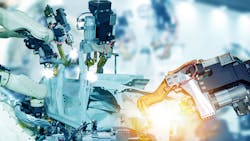The future of operations is a hyper-connected, data-transparent environment. Production assets, “things,” processes, and humans all provide behavioral data in real time. This information is accessible from anywhere at any time.
IT tools will provide operators and engineers with data to manage processes effectively. The most common digital tools used in operations include control towers, converged IT and operational technology (OT) systems, and enterprise IT systems. Such tools boost operational flexibility, enabling staff to predict problems and react accordingly.
The Legacy of Human-Centered Technology
Humans remain at the center of operations. The technology may leverage cognitive artificial intelligence (AI), machine learning (ML) algorithms, and cloud and edge computing, but the decisive actions are still made by humans. The term “human-centered technology” refers to the need for a human to control or execute a technological process.
Human-centered technology presents advantages and risks. Advantages include the human ability to contextualize data across siloed sources, to take a holistic view of disconnected processes, and to understand the behavior of other humans.
But it is impossible for the human brain to supervise the entirety of vertical and horizontal processes, technology setups, and operational data in a “data-hungry” real-time, connected environment. Crucial events or processes will be missed. Misjudgments or mistakes will be made.
The Future of Operations and Industry 4.0
Many organizations currently deploy operational assets that can be operated and reconfigured without direct human input. But these assets still require the triggering of a signal by a human operator (e.g., a production engineer).
This reality remains distant from the initial conception of Industry 4.0, which envisions truly autonomous cyberphysical systems. However, organizations are slowly proceeding toward the Industry 4.0 ideal—and the future of operations is a key element of the journey.
The future of operations is based on the following principles and assumptions:
- Smart assets and processes provide data that is sorted and analyzed at the edge by leveraging cloud computing and cloud applications.
- Always-on connectivity and full automation enables the set-up, maintenance, and reconfiguration of technology in an autonomous way.
- Seamlessly integrated internal value chains (e.g., order-to-deliver, servicing) autonomously interface with the external environment, enterprise IT and OT, and engineering technology.
- Faster decision-making is enabled by anywhere, anytime data accessibility.
- Algorithms enable vertically and horizontally synchronized operational processes, tasks, actions, logistics, and resource management.
- OT requires no physical interaction with a human operator in terms of setup, control, and monitoring, but collaboration between human and machine may still occur (e.g., collaborative robots).
- Cognitive AI and ML replace the human brain and eyes in complex processes requiring insights and information beyond core processes (e.g., end-to-end planning, inputs from weather forecasts and stock exchanges).
- Digital twins and threads are leveraged to provide predictions based on real-time simulation of processes and product behaviors during the entire life cycle.
- Converged IT and OT systems are protected by next-generation proactive security.
What to Expect in the Medium Term
A series of barriers must still be overcome to achieve fully autonomous operations environments. These include the continued use of legacy IT and OT systems, CAPEX and OPEX limitations, security concerns, and some humans’ lack of trust in technology that operates completely independent of humans.
How are operations in the operations-intensive organization likely to change in the next five to 10 years?
- Automation will become a key component of OT and IT systems integration, facilitating autonomous production and other autonomous processes.
- The nascent trend to exclude the human brain, hands, and eyes—not just from the edge, but even from the digital process—will accelerate.
- Current methods of data visualization and insight creation will become obsolete. All of these processes will be fully touchless and lights out.
- Will the role of humans change significantly as more complex processes are automated?
The advance of technology will continue to reduce the number of human job roles in the manufacturing environment. As technology becomes smarter, self-healing, and self-configurable, the decline in the total number of people working in manufacturing will accelerate over the next decade, particularly in Western Europe and the United States.
It is likely some current human job roles in manufacturing will fade away—but new roles will emerge. IDC recognizes the rising importance of digital engineers in terms of analytics and AI modeling support, development, and life-cycle management. Experts on digital twins, operational semantics arbitration, tags, frameworks, digital project management, and ecosystem management will be in demand.
Industry 4.0: Are We There Yet?
For organizations to move forward, legacy IT systems and legacy operational assets must be transitioned away from — and the rationale for their replacement by next-generation technology must go beyond short-term ROI targets and investment plans. The key motivators of significant change in operations must be improvements of employee health and safety and the establishment of sustainable operations and growth.
Investment agendas in the coming years will be driven by the possibilities suggested by emerging technologies. Current ways of operation will be massively disrupted as organizations digitally transform and integrate digital technologies horizontally and vertically.
The realization of Industry 4.0 is still a ways off—but we are heading in the right direction.
Jan Burian is senior director, head of IDC Manufacturing Insights EMEA and leader of Europe: Future of Operations Practice.
About the Author
Jan Burian
Senior Director, IDC
Jan Burian is senior director, head of IDC Manufacturing Insights EMEA and leader of Europe: Future of Operations Practice.
